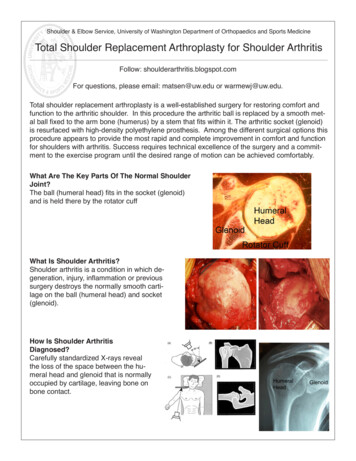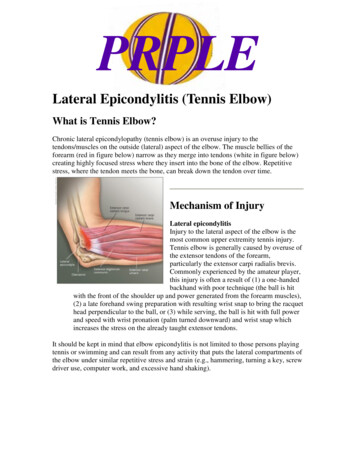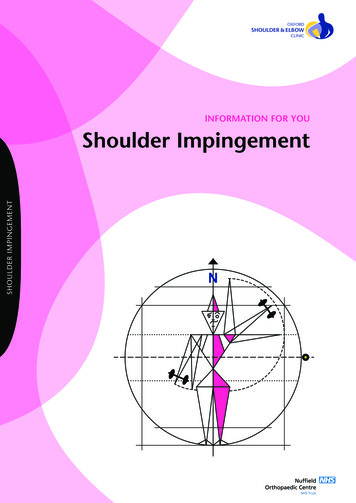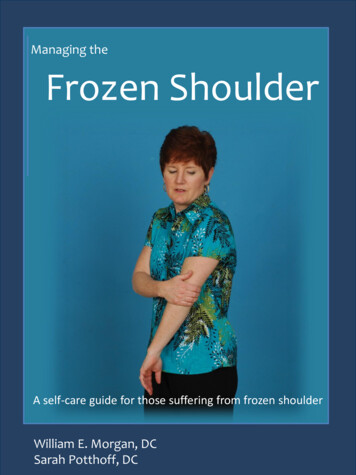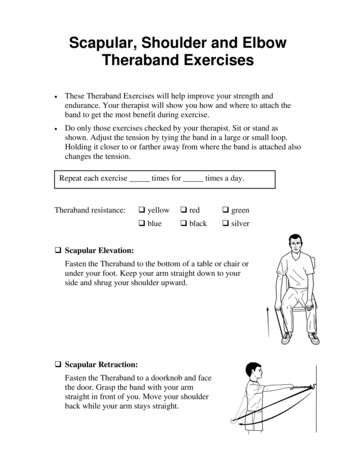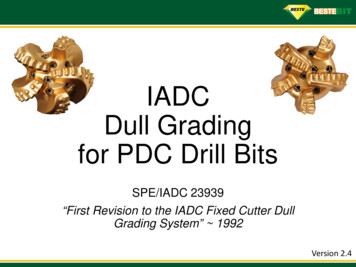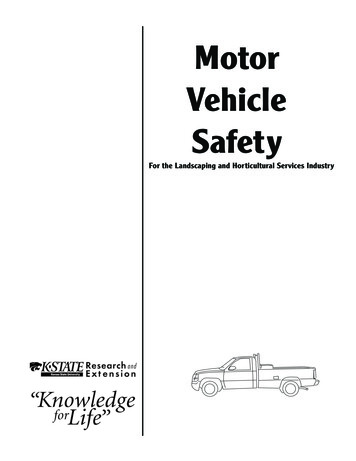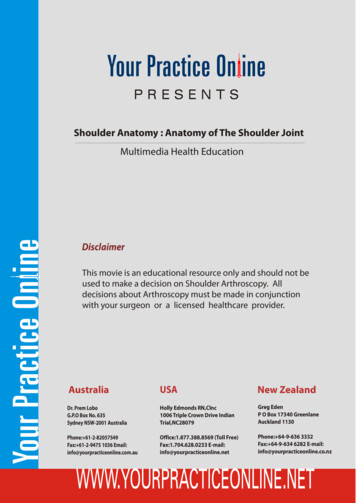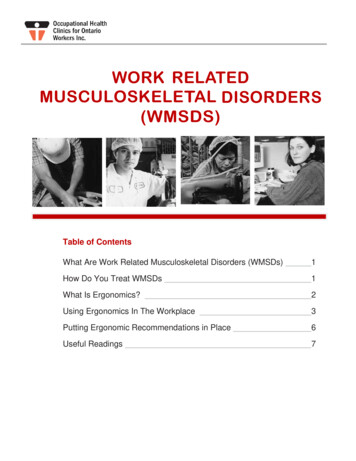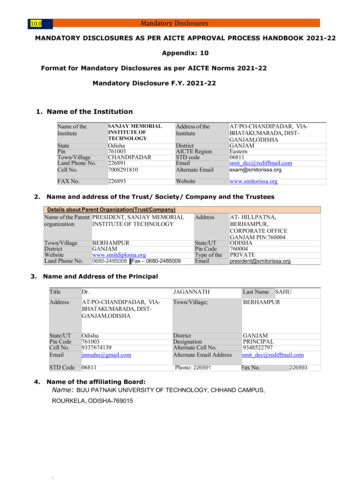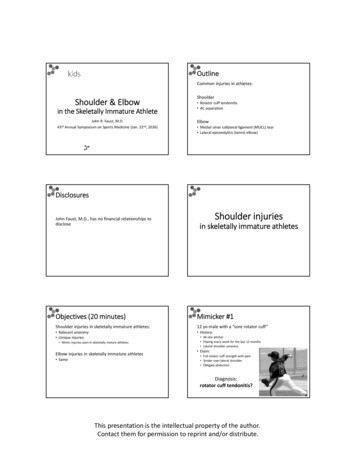
Transcription
OutlineCommon injuries in athletes:Shoulder & Elbowin the Skeletally Immature AthleteJohn R. Faust, M.D.43rd Annual Symposium on Sports Medicine (Jan. 22nd, 2016)Shoulder Rotator cuff tendonitis AC separationElbow Medial ulnar collateral ligament (MUCL) tear Lateral epicondylitis (tennis elbow)DisclosuresJohn Faust, M.D., has no financial relationships todiscloseShoulder injuriesin skeletally immature athletesObjectives (20 minutes)Mimicker #1Shoulder injuries in skeletally immature athletes:12 yo male with a “sore rotator cuff” Relevant anatomy Unique injuries History: Mimic injuries seen in skeletally mature athletesElbow injuries in skeletally immature athletes Same All‐star pitcher Playing every week for the last 12 months Lateral shoulder soreness Exam: Full rotator cuff strength with pain Tender over lateral shoulder Obligate abductionDiagnosis:rotator cuff tendonitis?This presentation is the intellectual property of the author.Contact them for permission to reprint and/or distribute.
Mimicker #1Mechanism of physeal stress injuriesSome recent studies define the mechanism of physeal stress injury as:His radiographs Begins in the metaphysis with disruption of the normal metaphyseal blood supply Absent blood flow disrupts endochondral bone formation Long columns of hypertrophic cartilage cells from the physis extend into themetaphysis Cartilage signal intensity of apparent physeal widening seen on MRI These areas of physeal widening differ from SH‐1 injuries: No discrete fracture is identified through the cartilageWidening can be focalNeither epiphyseal nor apophyseal displacement is seenJaramillo D, Radiology 1993; 187: 171‐178.Laor T, Pediatric Radiology 1997; 27: 654‐662.Laor T, AJR American journal of Roentgenology 2006; 186: 1260‐1264. The newly formed metaphyseal bone is fragile and unable to resist compressive,shear or tensile forces making the chondro‐osseous junction (COJ) susceptible toinjuryCarter SR, The Journal of Bone and Joint Surgery Br 1988; 70: 834‐836. The newly formed metaphysis (primary spongiosa) has only a few mineralized cartilage spikes toprovide strength The peripheral metaphyseal cortex is thin compared to the cortical thickness of the diaphysisDiagnosis:proximal humerus epiphysiolysis (little leaguer’s shoulder)Proximal humerus epiphysiolysisShoulder AnatomyOur patientProximal humeral physisNormal 10y 6m male Closure begins around 14 yoand finishes by 17 yoKwong S, AJR American Journal ofRoentgenology 2014; 202: 418‐425. Estimate for complete closure: 16 yo for females 18 yo for malesProximal humerus epiphysiolysisGrowth plate (physis) anatomyProximal humerus epiphysiolysis(Little leaguer’s shoulder)Endochondral bone growth Often misdiagnosed as rotator cuff tendonitis (seen inskeletally mature athletes) Rotator cuff tears almost non‐existent in teenagers, partialthickness tears exist but rarely the whole story and rarelyisolated Highest incidence in male baseball pitchers ages 11‐16 Peak incidence around puberty at age 14 Significant shear stress from the high torque in the latecocking/early acceleration phase of throwing Fastest recorded human motionSabick MB, Am J Sports Med 2005; 33: 1716‐1722. Thought to be an injury to the proximal humeral physissecondary to torsion and traction (but ) Salter Harris type I equivalent microfractureDotter WE, Guthrie Clin Bull, 1953 Jul;23(1):68‐72.Bishop JY, Clin Orthop Relat Res, 2005 Mar;(432):41‐8.Tullos HS, The Journal of Sports Medicine 1974; 2: 152‐153.Meister K, Am J Sports Med 2000; 28: 587‐601. Epiphyseal cartilage turns intomineralized osseous matrix Chondrocytes align in columns andprogress through defined zones: Resting Proliferative Hypertrophic Chondrocytes becoming separatedby increasing bands of mineralizedcartilage matrix starting in theproliferative zone and increasing indensity towards the chondro‐osseous junction (COJ) These mineralized cartilaginous strutsare the surfaces in the metaphysis onwhich osteoblasts differentiate,produce, and mineralize theextracellular matrix of boneThis presentation is the intellectual property of the author.Contact them for permission to reprint and/or distribute.
Proximal humerus epiphysiolysisMimicker #2DiagnosisHis radiograph History and exam Radiographs (AP of the bilateral shoulders in external rotation) MRI rarely neededTreatment Rest and structured PT: 2‐3 months Throwing program: light tossing then increase distance and velocity Education – pitch countsNatural history 91% return to sports and remain asymptomatic with structured PT Long‐term consequences rare due to remodeling potential of theproximal humerus 80% of the growth of the humerus is proximal Complications rare: Premature physeal closure length discrepancy, angular deformity Physeal fractureDiagnosis: distal clavicle fracturePitch CountsUSA Baseball: web.usabaseball.com Pitch counts are found in the article “Youth Baseball Pitching Injuries”near the bottom of the Medical Safety Reports page atweb.usabaseball.com/about/medical safety reports.jspUSA Baseball and MLB's Pitch Smart website notes: "Ultimately, it is the responsibility of the parent and the athlete toensure that the player follows the guidelines for his age group over thecourse of the year ‐ given that he will oftentimes play in multipleleagues with different affiliations covering different times of the year."Red: acromionOrange: coracoidLight green: distal clavicle fragmentYeah, rightGreen: proximal clavicle fragmentMimicker #2Distal clavicle fracture12 yo male “separated his shoulder” Distal clavicle ruptures through the periosteum Significant remodeling potential Tackled playing football, landed on his shoulder Exam: Prominent and tender distal claviclePeriosteum tornPeriosteal sleeve (where the bone will remodel)This presentation is the intellectual property of the author.Contact them for permission to reprint and/or distribute.
Distal clavicle fracturesMimicker #1Treatment:Radiographs from the 12 yo pitcher Initial treatment: sling Ortho follow‐up with in 1 week Definitive treatment: sling vs. ORIF Age (under/over 13 yo) Displacement Fracture pattern: Types I‐III: usually sling Types IV‐VI: sling vs. ORIFDameron and Rockwood ClassificationDiagnosis: medial epicondyle apophysitisMedial Epicondyle ApophysitisHis MRIElbow injuriesin skeletally immature athletesMimicker #1Elbow Anatomy12 yo male baseball player Best pitcher on the team Plays on multiple teamsyear round Medial elbow pain afterpitching11 yo female gymnast Level 10 Medial elbow pain afterfloor routinesMedial ulnar collateral ligament (MUCL) Proximal attachment to the inferior surface of the medialepicondyle apophysisDiagnosis:medial ulnar collateral ligament tear?This presentation is the intellectual property of the author.Contact them for permission to reprint and/or distribute.
Elbow AnatomyMechanics of Pitching InjuriesMedial ulnar collateral ligament (MUCL) Proximal attachment to the inferior surface of the medialepicondyle apophysis Distal attachment to the sublime tubercle of the ulna andthe medial ulnar crestDiGiovine NM, J Shoulder Elbow Surg 1992;1:15‐25.Elbow AnatomyMechanics of Pitching InjuriesMedial ulnar collateral ligament (MUCL)Pitching mechanics Proximal attachment to the inferior surface of the medialepicondyle apophysis Distal attachment to the sublime tubercle of the ulna andthe medial ulnar crest Anterior band of the MUCL is the primary ligamentousstabilizer of the elbow joint against valgus stress Late cocking/early acceleration: elbow flexing/extendingunder valgus stress Elbow anatomyMechanics of Pitching InjuriesOssification centers (age when appears)Shared mechanism of injury / spectrum of injury: Capitellum (1 yo) Radial head (3 yo) Medial epicondyle (5 yo) Appears as late as age 7 in males Fuses around age 15 in males Trochlea (7 yo) Olecranon (9 yo) Lateral epicondyle (12‐14 yo) Tensile force distracts the ulnar side Compressive forces on the radial side Abutment/shear of the olecranon on in the trochlea Valgus extension overloadSkeletally immatureUlnar tension forceBoth1. Medial epicondyle apophysitisMedial epicondyle avulsion fx Partial CompleteSkeletally matureMedial ulnar collateralligament (MUCL) tearRadial compressionforce1. Capitellar OCD2. OCD loose bodyRadiocapitellar arthritisOlecranon abutmentand shearOlecranon stressfractureOlecranon arthritis andosteophytesThis presentation is the intellectual property of the author.Contact them for permission to reprint and/or distribute.
Mechanics of Pitching InjuriesMedial Epicondyle Avulsion FractureAll together: valgus overload syndromePresentation Ages 7‐15 yo 3 mechanisms Avulsion Pop and pain Elbow buckles while tumbling Throwing a fastball Dislocation Direct trauma10‐20% of pediatric elbow fracture50‐60% associated with elbowdislocations Watch for fragment incarcerated in the elbowjoint Watch for ulnar nerve symptomsLittle Leaguer’s ElbowMedial epicondyle avulsion fractureValgus extension overload (VEO) stresses the medialepicondyle apophysis MUCL attaches to the medial epicondyle range of injuries referred to as Little Leaguer’s elbow: Medial epicondylar apophysitis (most common use) Accelerated apophyseal growth with delayed closure Medial epicondyle avulsion fracture (initial description) Complete avulsions ‐ true Salter‐Harris I physeal fracture Partial avulsionsMedial Epicondyle ApophysitisFracture displacementOveruse injuryPresentation: Patients 5‐15 yo (unfused medial epicondyle), but usually under 10 yo Insidious or acute onset medial elbow pain Medial epicondyle avulsion fractureDuring pitching or handstands Decreased throwing speed Decreased throwing distance Displaces anterior to the origin on themedial epicondyle In line with the pull of the flexor‐pronatormuscle mass Hard to measure on radiographs Internal oblique view bestImaging: Radiographs: widening of the medial epicondylar apophysis on radiographs MRI not usually necessaryExam: Edmonds E, J Bone Joint Surg 2010;92:2785‐91 45 internal oblique, multiply measurement by1.4 for best estimate Medial epicondyle tenderGottschalk HP, J Pediatr Orthop 2013;33:26‐31 Exact number needed to indicate surgery not knownTreatment: Rest, ice, anti‐inflammatories Activity modification – no valgus elbow stress No throwing, batting okay if no painNo handstands, floor routine, or vault Physical therapy – throwing program, pitching mechanics Gradual return to sports, pitch countsThis presentation is the intellectual property of the author.Contact them for permission to reprint and/or distribute.
Medial epicondyle avulsion fractureTreatment: Non‐operative: Brief immobilization for pain then mobilize to avoidstiffness Stiffness is the most common complication Fragment heals anterior MUCL tight in extension loss ofelbow extension Indications: Minimal displacement Non‐athletic typesof the capitellumLocalized disorder of subchondral bone causingseparation and fragmentation of the articular surface Chronic compressive forces at the radiocapitellararticulation Avascular necrosis of subchondral bone Same possible mechanism of injury as physeal stress injuries: Disruption of blood flow to the secondary epiphysis “metaphysealequivalent” Open reduction internal fixation Secure fixation allows safe and early ROM to avoid stiffness Indications: Osteochondritis Dissecans (OCD)Laor T, AJR Am J Roentgenol. 2013 Jan;200(1):232.Incarcerated fragmentOpen fractureThrowing athlete, gymnast, upper extremity athleteSignificant displacement (? mm or cm)Valgus instabilityElbow dislocation?Ulnar nerve symptoms?Osteochondritis Dissecans (OCD)Mimicker #2of the capitellum13 yo male baseball player Pitcher and catcher Lateral elbow sore afterevery game No injury12 yo female gymnast Elbow hurts after practiceand recently started locking No injuryPresentation: Overuse injury in gymnasts and throwersJones KJ, Ganley TJ, J Pediatr Orthop 2010;30(1):8‐12. Dull pain, worse with activity Popping or lockingExam Elbow tender laterally Asymmetric extensionDiagnosis:lateral epicondylitis (tennis elbow)?Osteochondritis Dissecans (OCD)Mimicker #2of the capitellum10y 5m gymnastDiagnosis:Osteochondritis Dissecans (OCD) of the capitellumThis presentation is the intellectual property of the author.Contact them for permission to reprint and/or distribute.
Osteochondritis Dissecans (OCD)Mimicker #3of the capitellumTreatment10 yo female gymnast Lateral elbow pain Sore during practice No mechanical symptoms Observation if asymptomatic Non‐operative: stable lesions Activity and weight bearing restriction Immobilization Surgery: Symptomatic despite immobilization, weight bearingand activity restrictionsUnstable fragmentLoose bodySurgical options: Arthroscopy Internal fixation Debridement and marrow stimulation / microfracture Osteochondral graftting Osteochondral autograft MosaicplastyOsteochondral autograft transfer system (OATS) Osteochondral allograft Best for large, deep, and uncontained lesionsDiagnosis:lateral epicondylitis (tennis elbow)?Shi, J Pediatr Orthop 2012Iwasaki ASJM 2006Osteochondritis Dissecans (OCD)Mimicker #3of the capitellumTreatment Location important Contained lesions – surrounded by normalcartilage Better outcome with marrow stimulation Uncontained lesions Osteochondral grafting Worse outcomes: 50% of the articular surface 1 cm diameter Uncontained lateral margin Return to sports: 25‐86% Depends on the study and the sportPanner’s DiseaseDiagnosis:Posterolateral Synovial ImpingementPanner’sPosterolateral Synovial ImpingementAVN of the capitellum ossific nucleusSynovial Impingement of the Posterolateral Elbow(SIPLE) “Perthes disease of the elbow” Etiology unclear Plica of the elbow Often recall an injury Exam: Likely due to lateral compression across theradiocapitellar joint 4‐8 yoDifference from OCD 10 yo NOT an overuse injury Benign natural historyOCDNatural history: Self‐limited Initial period of fragmentation then normalgrowth resumes Negative for epicondylitis provocative findings Tender at posterolateral aspect of the radiocapitellar joint Treatment: Rest, rest, rest Physical therapy and mechanics Arthroscopic resection (occasionally) Late sequelae rareTreatment: Rest then rehabilitationThis presentation is the intellectual property of the author.Contact them for permission to reprint and/or distribute.
Injuries shared with skeletally mature athletesSubluxating ulnar nerveSnapping triceps tendonPosterolateral rotatory instability (PLRI) (as approaching maturity)Ulnar collateral ligament (UCL) tear (as approaching maturity) Majority chronic overuse injuries Tommy John procedure (UCL reconstruction) Performed in 1974, returned to MLB pitching in 1976 with a 10‐10 record, retired after26 years in 1989Flexor‐pronator tendonitis (as approaching maturity)Children are not small adults andthe child athlete is not a little adult athleteSummaryShoulder Rotator cuff tendonitisProximal humerus epiphysiolysis(Little Leaguer’s shoulder) AC separationDistal clavicle fractureElbow UCL tearLittle Leaguer’s elbow(Medial epicondyle apophysitis orMedial epicondyle fracture) Tennis elbowOCD of capitellum orSynovial impingement (SIPLE)ReferencesKwong S, Kothary S, Poncinelli LL. Skeletal development of the proximal humerus in the pediatric population: MRI features.AJR American Journal of Roentgenology 2014; 202: 418‐425.Dotter WE. Little leaguer's shoulder: a fracture of the proximal epiphysial cartilage of the humerus due to baseball pitching.Guthrie Clin Bull. 1953 Jul;23(1):68‐72.Bishop JY, Flatow EL. Pediatric shoulder trauma. Clin Orthop Relat Res. 2005 Mar;(432):41‐8.Tullos HS, Fain RH. Little league shoulder: rotational stress fracture of proximal epiphysis. The Journal of Sports Medicine1974; 2: 152‐153.Meister K. Injuries to the shoulder in the throwing athlete. Part two: evaluation/treatment. The American Journal of SportsMedicine 2000; 28: 587‐601.Sabick MB, Kim YK, Torry MR et al. Biomechanics of the shoulder in youth baseball pitchers: implications for thedevelopment of proximal humeral epiphysiolysis and humeral retrotorsion. The American Journal of Sports Medicine 2005;33: 1716‐1722.Jaramillo D, Laor T, Zaleske DJ. Indirect trauma to the growth plate: results of MR imaging after epiphyseal and metaphysealinjury in rabbits. Radiology 1993; 187: 171‐178.Laor T, Hartman AL, Jaramillo D. Local physeal widening on MR imaging: an incidental finding suggesting prior metaphysealinsult. Pediatric Radiology 1997; 27: 654‐662.Laor T, Wall EJ, Vu LP. Physeal widening in the knee due to stress injury in child athletes. AJR American journal ofRoentgenology 2006; 186: 1260‐1264.Carter SR, Aldridge MJ. Stress injury of the distal radial growth plate. The Journal of Bone and Joint Surgery Br. 1988; 70: 834‐836.Furushima K, Itoh Y, Iwabu S, Yamamoto Y, Koga R, Shimizu M. Classification of Olecranon Stress Fractures in BaseballPlayers. Am J Sports Med. 2014 Jun;42(6):1343‐51.Laor T, Zbojniewicz AM, Eismann EA, Wall EJ. Juvenile osteochondritis dissecans: is it a growth disturbance of the secondaryphysis of the epiphysis? AJR Am J Roentgenol. 2012 Nov;199(5):1121‐8. doi: 10.2214/AJR.11.8085. Erratum in: AJR Am JRoentgenol. 2013 Jan;200(1):232.This presentation is the intellectual property of the author.Contact them for permission to reprint and/or distribute.
Dameron and Rockwood Classification Elbow injuries in skeletally immature athletes Mimicker #1 12 yo male baseball player Best pitcher on the team Plays on multiple teams year round Medial elbow pain after pitching 11 yo female gymnast Level 10 Medial elbow pain after floor routines Diagnosis:
